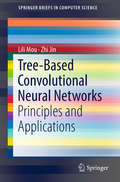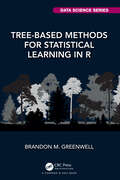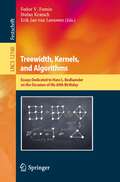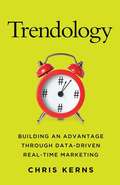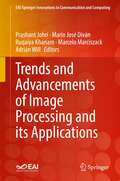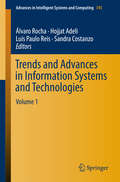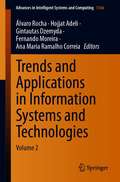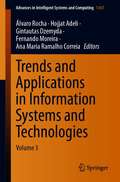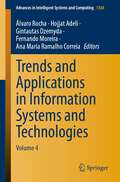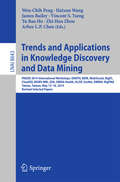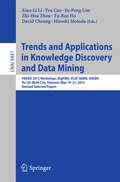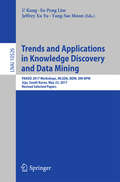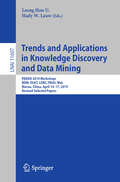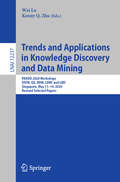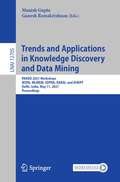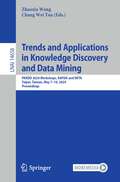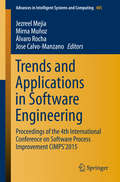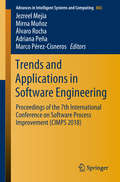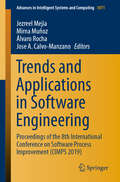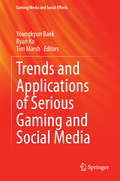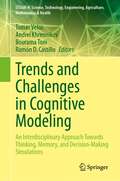- Table View
- List View
Tree-Based Convolutional Neural Networks: Principles and Applications (SpringerBriefs in Computer Science)
by Zhi Jin Lili MouThis book proposes a novel neural architecture, tree-based convolutional neural networks (TBCNNs),for processing tree-structured data. TBCNNsare related to existing convolutional neural networks (CNNs) and recursive neural networks (RNNs), but they combine the merits of both: thanks to their short propagation path, they are as efficient in learning as CNNs; yet they are also as structure-sensitive as RNNs. In this book, readers will also find a comprehensive literature review of related work, detailed descriptions of TBCNNs and their variants, and experiments applied to program analysis and natural language processing tasks. It is also an enjoyable read for all those with a general interest in deep learning.
Tree-Based Methods for Statistical Learning in R (Chapman & Hall/CRC Data Science Series)
by Brandon M. GreenwellTree-based Methods for Statistical Learning in R provides a thorough introduction to both individual decision tree algorithms (Part I) and ensembles thereof (Part II). Part I of the book brings several different tree algorithms into focus, both conventional and contemporary. Building a strong foundation for how individual decision trees work will help readers better understand tree-based ensembles at a deeper level, which lie at the cutting edge of modern statistical and machine learning methodology. The book follows up most ideas and mathematical concepts with code-based examples in the R statistical language; with an emphasis on using as few external packages as possible. For example, users will be exposed to writing their own random forest and gradient tree boosting functions using simple for loops and basic tree fitting software (like rpart and party/partykit), and more. The core chapters also end with a detailed section on relevant software in both R and other opensource alternatives (e.g., Python, Spark, and Julia), and example usage on real data sets. While the book mostly uses R, it is meant to be equally accessible and useful to non-R programmers. Consumers of this book will have gained a solid foundation (and appreciation) for tree-based methods and how they can be used to solve practical problems and challenges data scientists often face in applied work. Features: Thorough coverage, from the ground up, of tree-based methods (e.g., CART, conditional inference trees, bagging, boosting, and random forests). A companion website containing additional supplementary material and the code to reproduce every example and figure in the book. A companion R package, called treemisc, which contains several data sets and functions used throughout the book (e.g., there’s an implementation of gradient tree boosting with LAD loss that shows how to perform the line search step by updating the terminal node estimates of a fitted rpart tree). Interesting examples that are of practical use; for example, how to construct partial dependence plots from a fitted model in Spark MLlib (using only Spark operations), or post-processing tree ensembles via the LASSO to reduce the number of trees while maintaining, or even improving performance.
Treewidth, Kernels, and Algorithms: Essays Dedicated to Hans L. Bodlaender on the Occasion of His 60th Birthday (Lecture Notes in Computer Science #12160)
by Fedor V. Fomin Stefan Kratsch Erik Jan van LeeuwenThis Festschrift was published in honor of Hans L. Bodlaender on the occasion of his 60th birthday. The 14 full and 5 short contributions included in this volume show the many transformative discoveries made by H.L. Bodlaender in the areas of graph algorithms, parameterized complexity, kernelization and combinatorial games. The papers are written by his former Ph.D. students and colleagues as well as by his former Ph.D. advisor, Jan van Leeuwen.
Trendology
by Chris KernsIn this, the first data-driven guide to real time marketing, Chris Kerns outlines the value of RTM via a comprehensive social data performance analysis. He lays out best practices for measuring RTM, injects a data-driven mindset into every step of its methodology, and shows how marketers can grow RTM into a daily win for brands across the globe.
Trends and Advancements of Image Processing and Its Applications (EAI/Springer Innovations in Communication and Computing)
by Prashant Johri Mario José Diván Ruqaiya Khanam Marcelo Marciszack Adrián WillThis book covers current technological innovations and applications in image processing, introducing analysis techniques and describing applications in remote sensing and manufacturing, among others. The authors include new concepts of color space transformation like color interpolation, among others. Also, the concept of Shearlet Transform and Wavelet Transform and their implementation are discussed. The authors include a perspective about concepts and techniques of remote sensing like image mining, geographical, and agricultural resources. The book also includes several applications of human organ biomedical image analysis. In addition, the principle of moving object detection and tracking — including recent trends in moving vehicles and ship detection – is described.Presents developments of current research in various areas of image processing;Includes applications of image processing in remote sensing, astronomy, and manufacturing;Pertains to researchers, academics, students, and practitioners in image processing.
Trends and Advances in Information Systems and Technologies: Volume 1 (Advances In Intelligent Systems And Computing #745)
by Hojjat Adeli Álvaro Rocha Luís Paulo Reis Sandra CostanzoThis book includes a selection of papers from the 2018 World Conference on Information Systems and Technologies (WorldCIST'18), held in Naples, Italy on March27-29, 2018. WorldCIST is a global forum for researchers and practitioners to present and discuss recent results and innovations, current trends, professional experiences and the challenges of modern information systems and technologies research together with their technological development and applications. The main topics covered are: A) Information and Knowledge Management; B) Organizational Models and Information Systems; C) Software and Systems Modeling; D) Software Systems, Architectures, Applications and Tools; E) Multimedia Systems and Applications; F) Computer Networks, Mobility and Pervasive Systems; G) Intelligent and Decision Support Systems; H) Big Data Analytics and Applications; I) Human–Computer Interaction; J) Ethics, Computers & Security; K) Health Informatics; L) Information Technologies in Education; M) Information Technologies in Radiocommunications; N) Technologies for Biomedical Applications.
Trends and Advances in Information Systems and Technologies: Volume 1 (Advances In Intelligent Systems And Computing #745)
by Hojjat Adeli Álvaro Rocha Luís Paulo Reis Sandra CostanzoThis book includes a selection of papers from the 2018 World Conference on Information Systems and Technologies (WorldCIST'18), held in Naples, Italy on March27-29, 2018. WorldCIST is a global forum for researchers and practitioners to present and discuss recent results and innovations, current trends, professional experiences and the challenges of modern information systems and technologies research together with their technological development and applications.The main topics covered are: A) Information and Knowledge Management; B) Organizational Models and Information Systems; C) Software and Systems Modeling; D) Software Systems, Architectures, Applications and Tools; E) Multimedia Systems and Applications; F) Computer Networks, Mobility and Pervasive Systems; G) Intelligent and Decision Support Systems; H) Big Data Analytics and Applications; I) Human–Computer Interaction; J) Ethics, Computers & Security; K) Health Informatics; L) Information Technologies in Education; M) Information Technologies in Radiocommunications; N) Technologies for Biomedical Applications.
Trends and Advances in Information Systems and Technologies: Volume 1 (Advances In Intelligent Systems And Computing #745)
by Hojjat Adeli Álvaro Rocha Luís Paulo Reis Sandra CostanzoThis book includes a selection of papers from the 2018 World Conference on Information Systems and Technologies (WorldCIST'18), held in Naples, Italy on March27-29, 2018. WorldCIST is a global forum for researchers and practitioners to present and discuss recent results and innovations, current trends, professional experiences and the challenges of modern information systems and technologies research together with their technological development and applications. The main topics covered are: A) Information and Knowledge Management; B) Organizational Models and Information Systems; C) Software and Systems Modeling; D) Software Systems, Architectures, Applications and Tools; E) Multimedia Systems and Applications; F) Computer Networks, Mobility and Pervasive Systems; G) Intelligent and Decision Support Systems; H) Big Data Analytics and Applications; I) Human–Computer Interaction; J) Ethics, Computers & Security; K) Health Informatics; L) Information Technologies in Education; M) Information Technologies in Radiocommunications; N) Technologies for Biomedical Applications.
Trends and Applications in Information Systems and Technologies: Volume 1 (Advances in Intelligent Systems and Computing #1365)
by Hojjat Adeli Álvaro Rocha Gintautas Dzemyda Fernando Moreira Ana Maria Ramalho CorreiaThis book is composed of a selection of articles from The 2021 World Conference on Information Systems and Technologies (WorldCIST'21), held online between 30 and 31 of March and 1 and 2 of April 2021 at Hangra de Heroismo, Terceira Island, Azores, Portugal.WorldCIST is a global forum for researchers and practitioners to present and discuss recent results and innovations, current trends, professional experiences and challenges of modern information systems and technologies research, together with their technological development and applications.The main topics covered are: A) Information and Knowledge Management; B) Organizational Models and Information Systems; C) Software and Systems Modeling; D) Software Systems, Architectures, Applications and Tools; E) Multimedia Systems and Applications; F) Computer Networks, Mobility and Pervasive Systems; G) Intelligent and Decision Support Systems; H) Big Data Analytics and Applications; I) Human–Computer Interaction; J) Ethics, Computers & Security; K) Health Informatics; L) Information Technologies in Education; M) Information Technologies in Radiocommunications; N) Technologies for Biomedical Applications.
Trends and Applications in Information Systems and Technologies: Volume 2 (Advances in Intelligent Systems and Computing #1366)
by Hojjat Adeli Álvaro Rocha Gintautas Dzemyda Fernando Moreira Ana Maria Ramalho CorreiaThis book is composed of a selection of articles from The 2021 World Conference on Information Systems and Technologies (WorldCIST'21), held online between 30 and 31 of March and 1 and 2 of April 2021 at Hangra de Heroismo, Terceira Island, Azores, Portugal.WorldCIST is a global forum for researchers and practitioners to present and discuss recent results and innovations, current trends, professional experiences and challenges of modern information systems and technologies research, together with their technological development and applications. The main topics covered are: A) Information and Knowledge Management; B) Organizational Models and Information Systems; C) Software and Systems Modeling; D) Software Systems, Architectures, Applications and Tools; E) Multimedia Systems and Applications; F) Computer Networks, Mobility and Pervasive Systems; G) Intelligent and Decision Support Systems; H) Big Data Analytics and Applications; I) Human–Computer Interaction; J) Ethics, Computers & Security; K) Health Informatics; L) Information Technologies in Education; M) Information Technologies in Radiocommunications; N) Technologies for Biomedical Applications.
Trends and Applications in Information Systems and Technologies: Volume 3 (Advances in Intelligent Systems and Computing #1367)
by Hojjat Adeli Álvaro Rocha Gintautas Dzemyda Fernando Moreira Ana Maria Ramalho CorreiaThis book is composed of a selection of articles from The 2021 World Conference on Information Systems and Technologies (WorldCIST'21), held online between 30 and 31 of March and 1 and 2 of April 2021 at Hangra de Heroismo, Terceira Island, Azores, Portugal.WorldCIST is a global forum for researchers and practitioners to present and discuss recent results and innovations, current trends, professional experiences and challenges of modern information systems and technologies research, together with their technological development and applications.The main topics covered are: A) Information and Knowledge Management; B) Organizational Models and Information Systems; C) Software and Systems Modeling; D) Software Systems, Architectures, Applications and Tools; E) Multimedia Systems and Applications; F) Computer Networks, Mobility and Pervasive Systems; G) Intelligent and Decision Support Systems; H) Big Data Analytics and Applications; I) Human–Computer Interaction; J) Ethics, Computers & Security; K) Health Informatics; L) Information Technologies in Education; M) Information Technologies in Radiocommunications; N) Technologies for Biomedical Applications.
Trends and Applications in Information Systems and Technologies: Volume 4 (Advances in Intelligent Systems and Computing #1368)
by Hojjat Adeli Álvaro Rocha Gintautas Dzemyda Fernando Moreira Ana Maria Ramalho CorreiaThis book is composed of a selection of articles from The 2021 World Conference on Information Systems and Technologies (WorldCIST'21), held online between 30 and 31 of March and 1 and 2 of April 2021 at Hangra de Heroismo, Terceira Island, Azores, Portugal.WorldCIST is a global forum for researchers and practitioners to present and discuss recent results and innovations, current trends, professional experiences and challenges of modern information systems and technologies research, together with their technological development and applications.The main topics covered are: A) Information and Knowledge Management; B) Organizational Models and Information Systems; C) Software and Systems Modeling; D) Software Systems, Architectures, Applications and Tools; E) Multimedia Systems and Applications; F) Computer Networks, Mobility and Pervasive Systems; G) Intelligent and Decision Support Systems; H) Big Data Analytics and Applications; I) Human–Computer Interaction; J) Ethics, Computers & Security; K) Health Informatics; L) Information Technologies in Education; M) Information Technologies in Radiocommunications; N) Technologies for Biomedical Applications.
Trends and Applications in Knowledge Discovery and Data Mining
by James Bailey Zhi-Hua Zhou Wen-Chih Peng Haixun Wang Vincent S. Tseng Tu Bao Ho Arbee L.P. ChenThis book constitutes the refereed proceedings at PAKDD Workshops 2014, held in conjunction with the 18th Pacific-Asia Conference on Knowledge Discovery and Data Mining (PAKDD) held in Tainan, Taiwan, in May 2014. The 73 revised papers presented were carefully reviewed and selected from 179 submissions. The workshops affiliated with PAKDD 2014 include: Data Analytics for Targeted Healthcare, DANTH; Data Mining and Decision Analytics for Public Health and Wellness, DMDA-Health; Biologically Inspired Data Mining Techniques, BDM; Mobile Data Management, Mining, and Computing on Social Networks, MobiSocial; Big Data Science and Engineering on E-Commerce, BigEC; Cloud Service Discovery, CloudSD; Mobile Sensing, Mining and Visualization for Human Behavior Inferences, MSMV-HBI; Scalable Dats Analytics: Theory and Algorithms, SDA; Algorithms for Large-Scale Information Processing in Knowledge Discovery, ALSIP; Data Mining in Social Networks, SocNet; Data Mining in Biomedical Informatics and Healthcare, DMBIH; and Pattern Mining and Application of Big Data, BigPMA.
Trends and Applications in Knowledge Discovery and Data Mining
by Zhi-Hua Zhou Xiao-Li Li Tru Cao Ee-Peng Lim Tu-Bao Ho David CheungThis book constitutes the refereed proceedings at PAKDD Workshops 2015, held in conjunction with PAKDD, the 19th Pacific-Asia Conference on Knowledge Discovery and Data Mining in Ho Chi Minh City, Vietnam, in May 2015. The 23 revised papers presented were carefully reviewed and selected from 57 submissions. The workshops affiliated with PAKDD 2015 include: Pattern Mining and Application of Big Data (BigPMA), Quality Issues, Measures of Interestingness and Evaluation of data mining models (QIMIE), Data Analytics for Evidence-based Healthcare (DAEBH), Vietnamese Language and Speech Processing (VLSP).
Trends and Applications in Knowledge Discovery and Data Mining
by Ee-Peng Lim Yang-Sae Moon U Kang Jeffrey Xu YuThis book constitutes the thoroughly refereed post-workshop proceedings at PAKDD Workshops 2017, held in conjunction with PAKDD, the 21st Pacific-Asia Conference on Knowledge Discovery and Data Mining in May 2017 in Jeju, South Korea. The 17 revised papers presented were carefully reviewed and selected from 38 submissions. The workshops affiliated with PAKDD 2017 include: Workshop on Machine Learning for Sensory Data Analysis (MLSDA), Workshop on Biologically Inspired Data Mining Techniques (BDM), Pacific Asia Workshop on Intelligence and Security Informatics (PAISI), and Workshop on Data Mining in Business Process Management (DM-BPM).
Trends and Applications in Knowledge Discovery and Data Mining: PAKDD 2018 Workshops, BDASC, BDM, ML4Cyber, PAISI, DaMEMO, Melbourne, VIC, Australia, June 3, 2018, Revised Selected Papers (Lecture Notes in Computer Science #11154)
by Mohadeseh Ganji Lida Rashidi Benjamin C. Fung Can WangThis book constitutes the thoroughly refereed post-workshop proceedings at PAKDD Workshops 2018, held in conjunction with the 22nd Pacific-Asia Conference on Knowledge Discovery and Data Mining, PAKDD 2018, in Melbourne, Australia, in June 2018. The 32 revised papers presented were carefully reviewed and selected from 46 submissions. The workshops affiliated with PAKDD 2018 include: Workshop on Big Data Analytics for Social Computing, BDASC, Australasian Workshop on Machine Learning for Cyber-security, ML4Cyber, Workshop on Biologically-inspired Techniques for Knowledge Discovery and Data Mining, BDM, Pacific Asia Workshop on Intelligence and Security Informatics, PAISI, and Workshop on Data Mining for Energy Modeling and Optimization, DaMEMO.
Trends and Applications in Knowledge Discovery and Data Mining: PAKDD 2019 Workshops, BDM, DLKT, LDRC, PAISI, WeL, Macau, China, April 14–17, 2019, Revised Selected Papers (Lecture Notes in Computer Science #11607)
by Leong Hou U. Hady W. LauwThis book constitutes the thoroughly refereed post-workshop proceedings of the workshops that were held in conjunction with the 23rd Pacific-Asia Conference on Knowledge Discovery and Data Mining, PAKDD 2019, in Macau, China, in April 2019.The 31 revised papers presented were carefully reviewed and selected from a total of 52 submissions. They stem from the following workshops: · PAISI 2019: 14th Pacific Asia Workshop on Intelligence and Security Informatics · WeL 2019: PAKDD 2019 Workshop on Weakly Supervised Learning: Progress and Future · LDRC 2019: PAKDD 2019 Workshop on Learning Data Representation for Clustering· BDM 2019: 8th Workshop on Biologically-inspired Techniques for Knowledge Discovery and Data Mining · DLKT 2019: 1st Pacific Asia Workshop on Deep Learning for Knowledge Transfer
Trends and Applications in Knowledge Discovery and Data Mining: PAKDD 2020 Workshops, DSFN, GII, BDM, LDRC and LBD, Singapore, May 11–14, 2020, Revised Selected Papers (Lecture Notes in Computer Science #12237)
by Wei Lu Kenny Q. ZhuThis book constitutes the thoroughly refereed post-workshop proceedings of the workshops that were held in conjunction with the 24th Pacific-Asia Conference on Knowledge Discovery and Data Mining, PAKDD 2020, in Singapore, Singapore, in May 2020. The 17 revised full papers presented were carefully reviewed and selected from a total of 50 submissions. The five workshops were as follows: · First International Workshop on Literature-Based Discovery (LBD 2020) · Workshop on Data Science for Fake News (DSFN 2020)· Learning Data Representation for Clustering (LDRC 2020)· Ninth Workshop on Biologically Inspired Techniques for Data Mining (BDM· 2020)· First Pacific Asia Workshop on Game Intelligence & Informatics (GII 2020)
Trends and Applications in Knowledge Discovery and Data Mining: PAKDD 2021 Workshops, WSPA, MLMEIN, SDPRA, DARAI, and AI4EPT, Delhi, India, May 11, 2021 Proceedings (Lecture Notes in Computer Science #12705)
by Manish Gupta Ganesh RamakrishnanThis book constitutes the refereed proceedings of five workshops that were held in conjunction with the 25th Pacific-Asia Conference on Knowledge Discovery and Data Mining, PAKDD 2021, in Delhi, India, in May 2021. The 17 revised full papers presented were carefully reviewed and selected from a total of 39 submissions.. The five workshops were as follows: Workshop on Smart and Precise Agriculture (WSPA 2021) PAKDD 2021 Workshop on Machine Learning for Measurement Informatics (MLMEIN 2021) The First Workshop and Shared Task on Scope Detection of the Peer Review Articles (SDPRA 2021) The First International Workshop on Data Assessment and Readiness for AI (DARAI 2021) The First International Workshop on Artificial Intelligence for Enterprise Process Transformation (AI4EPT 2021)
Trends and Applications in Knowledge Discovery and Data Mining: PAKDD 2024 Workshops, RAFDA and IWTA, Taipei, Taiwan, May 7–10, 2024, Proceedings (Lecture Notes in Computer Science #14658)
by Zhaoxia Wang Chang Wei TanThis book constitutes the workshops that have been held in conjunction with the 27th Pacific-Asia Conference on Knowledge Discovery and Data Mining, PAKDD 2023, which took place in Osaka, Japan, during May 25–28, 2023. For RAFDA 2024, Workshop on Research and Applications of Foundation Models for Data Mining and Affective Computing, 15 submissions have been received and 9 full papers have been accepted for publication. For IWTA 2024, International Workshop on Temporal Analytics, 4 full papers have been accepted from a total of 6 submissions.
Trends and Applications in Software Engineering
by Jezreel Mejia Mirna Munoz Álvaro Rocha Jose Calvo-ManzanoThis book contains a selection of papers from The 2015 International Conference on Software Process Improvement (CIMPS'15), held between the 28th and 30th of October in Mazatlán, Sinaloa, México. The CIMPS'15 is a global forum for researchers and practitioners that present and discuss the most recent innovations, trends, results, experiences and concerns in the several perspectives of Software Engineering with clear relationship but not limited to software processes, Security in Information and Communication Technology and Big Data Field. The main topics covered are: Organizational Models, Standards and Methodologies, Knowledge Management, Software Systems, Applications and Tools, Information and Communication Technologies and Processes in non-software domains (Mining, automotive, aerospace, business, health care, manufacturing, etc. ) with a demonstrated relationship to software process challenges.
Trends and Applications in Software Engineering: Proceedings Of The 6th International Conference On Software Process Improvement (cimps 2017) (Advances In Intelligent Systems and Computing #688)
by Jezreel Mejia Álvaro Rocha Marco Pérez-Cisneros Mirna Muñoz Adriana PeñaThis book gathers a selection of papers presented at the 2018 International Conference on Software Process Improvement (CIMPS 2018). CIMPS 2018 offered a global forum for researchers and practitioners to present and discuss the latest innovations, trends, findings, experiences and concerns in Software Engineering, embracing several aspects such as Software Processes, Security in Information and Communication Technology, and Big Data. Two of the conference’s main aims were to support the drive toward a holistic symbiosis of the academic world, society, industry, government and business community, and to promote the creation of networks by disseminating the results of recent research in order to align their needs. CIMPS 2018 was made possible by the support of the CIMAT A.C., CUCEI (Universidad de Guadalajara, México), AISTI (Associação Ibérica de Sistemas e Tecnologas de Informação), and ReCIBE (Revista electrónica de Computación, Informática, Biomédica y Electrónica).
Trends and Applications in Software Engineering: Proceedings of the 8th International Conference on Software Process Improvement (CIMPS 2019) (Advances in Intelligent Systems and Computing #1071)
by Jezreel Mejia Álvaro Rocha Mirna Muñoz Jose A. Calvo-ManzanoThis book contains a selection of papers from The 2019 International Conference on Software Process Improvement (CIMPS’19), held between the 23th and 25th of October in León, Guanajuato, México. The CIMPS’19 is a global forum for researchers and practitioners that present and discuss the most recent innovations, trends, results, experiences and concerns in the several perspectives of Software Engineering with clear relationship but not limited to software processes, Security in Information and Communication Technology and Data Analysis Field.The main topics covered are: Organizational Models, Standards and Methodologies, Software Process Improvement, Knowledge Management, Software Systems, Applications and Tools, Information and Communication Technologies and Processes in non-software domains (Mining, automotive, aerospace, business, health care, manufacturing, etc.) with a demonstrated relationship to Software Engineering Challenges.
Trends and Applications of Serious Gaming and Social Media
by Youngkyun Baek Ryan Ko Tim MarshThis book highlights the challenges and potential of educational learning or industry-based training using serious games and social media platforms. In particular, the book addresses applications used in businesses and education-related organizations in Asia, where the framework and experience of serious games have been used to address specific problems in the real world. The topics that will be present in this book includes future of serious games and immersive technologies and their impact on society; online and mobile games; achievement systems in serious games; persuasive technology and games for saving and money management; malware analytics for social networking; serious games for mental health interventions; educational implications of social network games; learning and acquiring subject knowledge using serious games in classrooms. The target audience for this book includes scientists, engineers and practitioners involved in the field of Serious Games. The major part of this book comprises of papers that have been presented at the Serious Games and Social Connect 2012 conference held in Singapore (October 4, 2012). All the contributions have been peer reviewed and by scientific committee members with report about quality, content and originality.
Trends and Challenges in Cognitive Modeling: An Interdisciplinary Approach Towards Thinking, Memory, and Decision-Making Simulations (STEAM-H: Science, Technology, Engineering, Agriculture, Mathematics & Health)
by Bourama Toni Andrei Khrennikov Tomas Veloz Ramón D. CastilloThis book presents interdisciplinary research in the science of Human Cognition through mathematical and computational modeling and simulation. Featuring new approaches developed by leading experts in the field of cognitive science, it highlights the relevance and depth of this important area of social sciences and its expanding reach into the biological, physical, computational and mathematical sciences. This contributed volume compiles the most recent advancements and cutting-edge applications of cognitive modeling, employing a genuinely multidisciplinary approach to simulate thinking, memory, and decision-making. The topics covered encompass a wide range of subjects, such as Agent-based Modeling in psychological research, the Nyayasutra proof pattern, the utilization of the Pheromone Trail Algorithm for modeling Analog Memory, the theory and practical applications of Social Laser Theory, addressing the challenges of probabilistic learning in brain and behavior models, adopting a Physicalistic perspective to understand the emergence of cognition and computation, an in-depth analysis of the conjunction fallacy as a factual occurrence, exploring quantum modeling and causality in physics and its extensions, examining compositional vector semantics within spiking neural networks, delving into the realms of Optimality, Prototypes, and Bilingualism, and finally, investigating the intricate dimensionality of color perception. Given its scope and approach, the book will benefit researchers and students of computational social sciences, mathematics and its applications, quantum physics.
